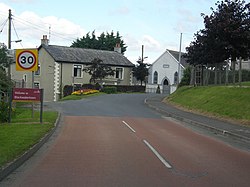Blackwatertown: Difference between revisions
Created page with '{{Infobox town |name=Blackwatertown |county=Armagh |picture= |picture caption= |os grid ref=H8452 |LG district=Armagh }} '''Blackwatertown''' is a village in County Armagh, o…' |
No edit summary |
||
| (One intermediate revision by the same user not shown) | |||
| Line 2: | Line 2: | ||
|name=Blackwatertown | |name=Blackwatertown | ||
|county=Armagh | |county=Armagh | ||
|picture= | |picture=Entering Blackwatertown on the B128 - geograph.org.uk - 531630.jpg | ||
|picture caption= | |picture caption=Entering Blackwatertown | ||
|os grid ref= | |os grid ref=H843524 | ||
|LG district=Armagh | |latitude=54.413128 | ||
|longitude=-6.7017404 | |||
|population= | |||
|census year= | |||
|post town= | |||
|postcode= | |||
|dialling code= | |||
|LG district=Armagh, Banbridge and Craigavon | |||
|constituency= | |||
}} | }} | ||
'''Blackwatertown''' is a village in [[County Armagh]] | '''Blackwatertown''', sometimes referred to as '''Blackwaterstown''', is a small village in the [[townland]] of [[Lisbofin]], [[County Armagh]]. It stands beside the [[River Blackwater, County Armagh|River Blackwater]], close to the border with [[Tyrone]]. | ||
{{ | The village had a population of 376 people in 150 households recorded by the 2011 Census. | ||
Blackwatertown was one of the first places in Northern Ireland to erect street signs in the Irish language in 1980. The village recently had signs erected at the entrances indicating its name; previously signs were erected by local individuals indicating its name in the Irish language. | |||
The River Blackwater enters [[Lough Neagh]] west of Derrywarragh Island and is navigable from [[Maghery]] to Blackwatertown. | |||
==History== | |||
In 1575, during the Tudor conquest of Ireland, the English built a fort at what is now Blackwatertown, to control this important river crossing in the heart of Gaelic [[Ulster]]. Most of the fort was on the eastern bank of the river, and there was a stone tower on the western bank. In February 1595, at the outset of the Nine Years' War, a Gaelic force led by Art MacBaron O'Neill assaulted and captured the fort from the English. | |||
This fort is referenced in the village's Irish name, ''An Port Mór'' ("the great fort").<ref name=pin>{{placenamesNI|17094|Blackwatertown}}</ref> The wider townland is also called Lisbofin, from ''Lios Bó Finne'' meaning "fort of the white cow",<ref name=pin/> which may refer to one of the ringforts in the area. | |||
==Sport== | |||
*Gaelic Athletic: Port Mór GAA | |||
*Boxing: St Jarlaths ABC. | |||
The ancient sport of Road Bowling, known as 'Bullets', is still played along country roads. In this sport, two players throw a small metal ball (the bullet) along a set distance on a road. The winner is the player who finishes in the fewest throws. This sport is very popular in most parts of County Armagh, and parts of [[County Cork|Cork]]. | |||
==In popular culture== | |||
A fictional 1950s version of Blackwatertown is the setting for the crime thriller ''Blackwatertown'' by Paul Waters, published in 2020.<ref>{{Cite web|url=http://www.irishnews.com/arts/2020/08/19/news/veteran-irish-journalist-and-producer-paul-waters-on-his-debut-novel-blackwatertown-2039449/|title=Irish News - Veteran Irish journalist and producer Paul Waters on his debut novel Blackwatertown}}</ref> | |||
{{commons}} | |||
==References== | |||
{{reflist}} | |||
Latest revision as of 22:47, 28 November 2022
| Blackwatertown | |
| County Armagh | |
|---|---|
 Entering Blackwatertown | |
| Location | |
| Grid reference: | H843524 |
| Location: | 54°24’47"N, 6°42’6"W |
| Data | |
| Local Government | |
| Council: | Armagh, Banbridge and Craigavon |
Blackwatertown, sometimes referred to as Blackwaterstown, is a small village in the townland of Lisbofin, County Armagh. It stands beside the River Blackwater, close to the border with Tyrone.
The village had a population of 376 people in 150 households recorded by the 2011 Census.
Blackwatertown was one of the first places in Northern Ireland to erect street signs in the Irish language in 1980. The village recently had signs erected at the entrances indicating its name; previously signs were erected by local individuals indicating its name in the Irish language.
The River Blackwater enters Lough Neagh west of Derrywarragh Island and is navigable from Maghery to Blackwatertown.
History
In 1575, during the Tudor conquest of Ireland, the English built a fort at what is now Blackwatertown, to control this important river crossing in the heart of Gaelic Ulster. Most of the fort was on the eastern bank of the river, and there was a stone tower on the western bank. In February 1595, at the outset of the Nine Years' War, a Gaelic force led by Art MacBaron O'Neill assaulted and captured the fort from the English.
This fort is referenced in the village's Irish name, An Port Mór ("the great fort").[1] The wider townland is also called Lisbofin, from Lios Bó Finne meaning "fort of the white cow",[1] which may refer to one of the ringforts in the area.
Sport
- Gaelic Athletic: Port Mór GAA
- Boxing: St Jarlaths ABC.
The ancient sport of Road Bowling, known as 'Bullets', is still played along country roads. In this sport, two players throw a small metal ball (the bullet) along a set distance on a road. The winner is the player who finishes in the fewest throws. This sport is very popular in most parts of County Armagh, and parts of Cork.
In popular culture
A fictional 1950s version of Blackwatertown is the setting for the crime thriller Blackwatertown by Paul Waters, published in 2020.[2]
| ("Wikimedia Commons" has material about Blackwatertown) |
